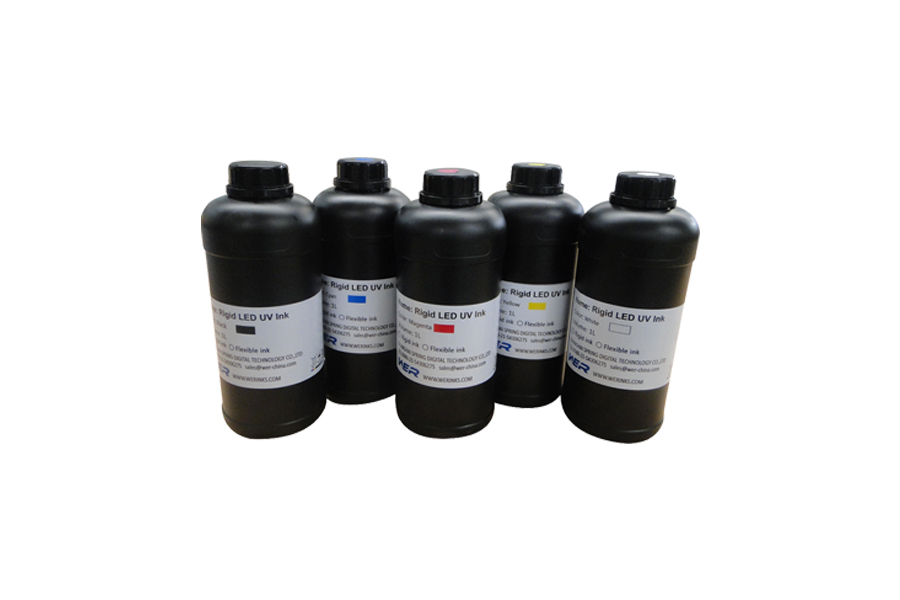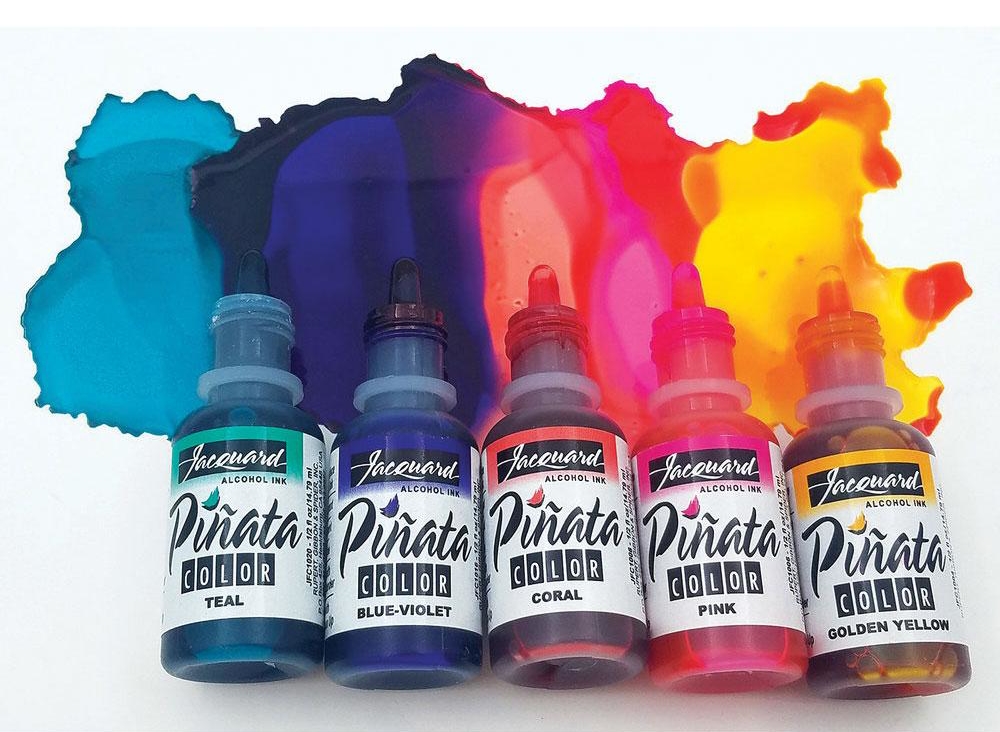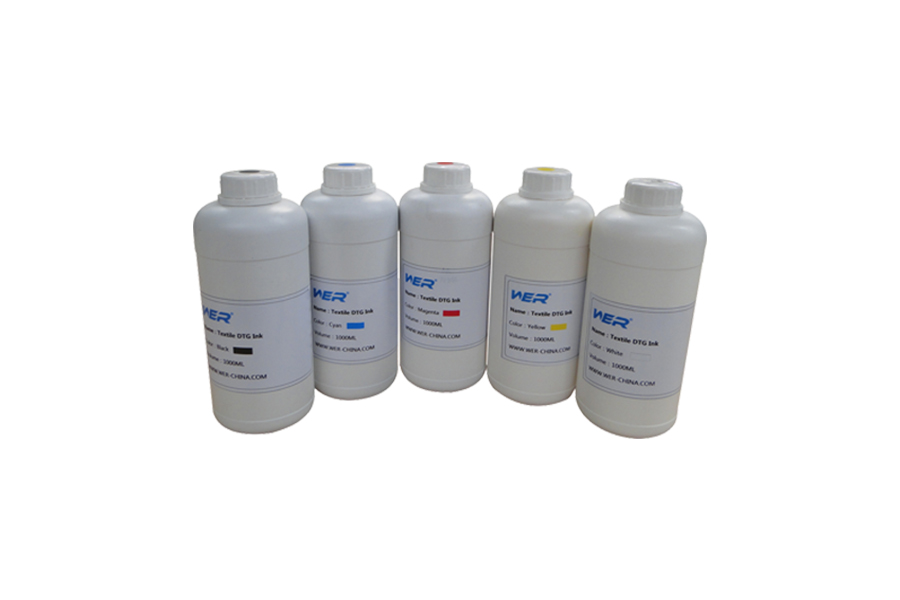1.energy curing ink Energy curing ink is the use of UV light or accelerated high-energy electron beam (EB) to polymerize the monomers in the ink into polymers. At present, energy-curable inks mainly include uv inks and EB inks.
Energy curing ink is the use of UV light or accelerated high-energy electron beam (EB) to polymerize the monomers in the ink into polymers. At present, energy-curable inks mainly include uv inks and EB inks.
Compared with ordinary inks, the main advantages of energy-curable inks are: no VOC harmful to the human body and the environment, no pollution to the environment, fast drying and curing speed, low energy consumption, high density of crosslinking and curing, and the curing degree can reach 100 %, can be printed on a variety of substrates, with excellent mechanical and physical and chemical properties. Therefore, as soon as the energy-curable ink was launched, it was sought after by the market.
UV ink is mainly composed of prepolymer resin, diluent monomer, photoinitiator, photosensitizer, photosensitizer, polymerization inhibitor and pigment. UV inks mainly include offset printing UV inks, relief printing UV inks, gravure printing UV inks, screen printing UV inks, UV inkjet inks, and UV printed circuit board inks.
The environmental protection of UV ink is only relative to the ordinary printing process, and there are many problems.
(1) When some components in UV ink come into contact with the skin, they will cause a certain irritation and even cause skin allergies.
(2) UV light has certain damage to the human body.
(3) The cured ink layer has a very high cross-linking density, which is difficult to degrade and the ink residue is also difficult to handle.
For this reason, people are actively researching and developing water-based UV inks, hoping to solve the problems of UV inks.
EB ink is a kind of ink variety with great development potential, which can be used in rotary offset printing and flexographic printing. Compared with UV ink, it does not use photoinitiator, is odorless, does not release ozone, does not require cold curing by a heat source, and is not affected by the color of the ink during curing. The curing is more thorough and the quality is more stable. However, the high cost of curing equipment for EB ink is the biggest obstacle in the promotion and application. At the same time, EB ink also has the problem of degradation after it is discarded.
At present, most of the inks used in gravure printing contain benzene solvents. Due to volatilization, the exhaust gas emitted by gravure printing is a great source of pollution in the packaging and printing industry. Although water-based gravure inks, as a substitute for solvent-based gravure inks, have attracted people’s attention and placed high expectations, the water-based progress of gravure inks is still slow.
The main reasons that hinder the water-based gravure ink are as follows.
(1)Poor printing qualityAt present, the adhesion and rub resistance of water-based inks to plastics are not strong, the printability is poor, and the printing effect is not as good as that of solvent-based inks.
(2) The dryness is not goodWater-based inks have poor drying properties, resulting in low printing speeds during printing, increasing energy consumption and costs. It is necessary to modify the original drying equipment or use a special printing machine suitable for water-based gravure inks.
(3) The printing plate must be modified
In order to improve the drying properties of water-based gravure inks and enhance the printing effect, the printing plate must be remodeled to achieve lighter version.
At present, the water-based gravure ink is still in research and development. Although there are reports that the research and development are successful, it only stays at the laboratory level, and there is still a process to achieve industrialization. However, water-based gravure inks have been tried on some special substrates. If the above problems are solved, the water-based gravure ink can achieve a wide range of applications.
2. Alcohol-soluble ink Solvent-based gravure inks want to achieve environmental protection while ensuring printing performance and quality. Alcohol-soluble inks have become the most possible variety, which is also the focus of research and development of major ink manufacturers.In addition, in the field of plastic flexible packaging printing, benzene-free inks are also very popular. At present, polyurethane inks are the main ones that have made progress. Many companies have successively developed benzene-free or ketone-free ink varieties, which are suitable for surface printing and lining of plastic films. , There are also alcohol-soluble inks made with special polyamide resin and polyvinyl butyral resin as the main body.
Solvent-based gravure inks want to achieve environmental protection while ensuring printing performance and quality. Alcohol-soluble inks have become the most possible variety, which is also the focus of research and development of major ink manufacturers.In addition, in the field of plastic flexible packaging printing, benzene-free inks are also very popular. At present, polyurethane inks are the main ones that have made progress. Many companies have successively developed benzene-free or ketone-free ink varieties, which are suitable for surface printing and lining of plastic films. , There are also alcohol-soluble inks made with special polyamide resin and polyvinyl butyral resin as the main body.
3.Environmentally friendly offset printing ink Offset printing inks account for almost 50% of the market share in my country. Environmentally friendly offset printing inks mainly include the following types.
Offset printing inks account for almost 50% of the market share in my country. Environmentally friendly offset printing inks mainly include the following types.
(1) vegetable oil-based offset printing inkThe use of lithographic printing inks has a long history. Due to the limitation of VOC emissions and the impact of its environment, vegetable oil-based offset printing inks are beginning to be favored by people. The American Soybean Oil Association has formulated special certification standards in order to popularize soybean oil inks. American soybean oil inks are gradually replacing ordinary offset printing inks and are widely used in commercial printing.
Soybean oil offset printing ink is the main variety of vegetable oil-based offset printing ink. At present, many ink companies and research institutions in my country are engaged in the research and manufacture of this type of ink. Vegetable oil-based offset printing inks have made progress, but there is currently no obvious advantage in the adaptability of high-speed printing, product quality, and sales price.
(2) aromatic-free offset printing ink
In Japan, almost all ink manufacturers have begun to use AF solvents with aromatic hydrocarbons (less than 1%) removed from ink solvents to improve the environmental pollution of inks during production and printing. It should be said that this kind of offset printing ink made with AF solvent is also an environmentally friendly ink, but there is no AF solvent available in my country, which also restricts the development of aromatic-free offset printing inks in China.
(3) waterless offset printing ink
Waterless offset printing uses an ink-repellent silicone resin-coated printing plate. The ink can be absorbed by removing the coating on the image and text part to achieve the transfer of the image and text. This saves the use of fountain solution and can be said to have made a great contribution to environmental protection. However, in the actual printing process, the waterless offset printing ink is greatly affected by the environmental temperature and is easy to get dirty. The transferability of the ink and the ink property of the ink are not as good as ordinary offset printing inks, and special waterless offset printing equipment is required. The application and promotion are affected. Certain restrictions. However, under the pressure of environmental protection, the United States and Japan have begun to actively try waterless offset printing, which is worthy of attention.
| M | T | W | T | F | S | S |
|---|---|---|---|---|---|---|
| 1 | 2 | 3 | 4 | 5 | 6 | |
| 7 | 8 | 9 | 10 | 11 | 12 | 13 |
| 14 | 15 | 16 | 17 | 18 | 19 | 20 |
| 21 | 22 | 23 | 24 | 25 | 26 | 27 |
| 28 | 29 | 30 | 31 | |||
Recent Posts
- Ultimate Guide to UV Printing: Insider Tips and Tricks
- Before You Invest: Choosing a Large Format Flatbed Printer
- Maximizing Brilliance: Mastering UV Printer Settings for Optimal Media Reflectivity
- The advantages of using a WER UV printer for large format printing (2)
- Achieve Stunning Results in Home Décor and Architectural Design with UV Printer
Archives
- January 2025
- November 2024
- September 2024
- March 2024
- December 2023
- November 2023
- October 2023
- May 2023
- March 2023
- February 2023
- January 2023
- December 2022
- November 2022
- October 2022
- September 2022
- February 2022
- January 2022
- December 2021
- November 2021
- October 2021
- September 2021
- August 2021
- July 2021
- June 2021
- May 2021
- April 2021
- March 2021
- February 2021
- January 2021
- December 2020
- November 2020
- October 2020
- September 2020
- August 2020
- July 2020
- June 2020
- May 2020
- April 2020
- March 2020
- February 2020
- January 2020
- December 2019
- November 2019
- October 2019
- September 2019
- August 2019
- July 2019
- June 2019
- May 2019
- April 2019
- March 2019
- February 2019
- January 2019
- December 2018
- November 2018
- October 2018
- September 2018
- August 2018
- July 2018
- June 2018
- May 2018
- April 2018
- March 2018
- February 2018
- January 2018
- December 2017
- July 2016
- June 2016
Recent Posts
- Ultimate Guide to UV Printing: Insider Tips and Tricks
- Before You Invest: Choosing a Large Format Flatbed Printer
- Maximizing Brilliance: Mastering UV Printer Settings for Optimal Media Reflectivity
- The advantages of using a WER UV printer for large format printing (2)
- Achieve Stunning Results in Home Décor and Architectural Design with UV Printer
Recent Comments